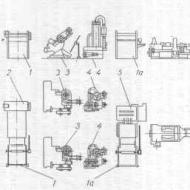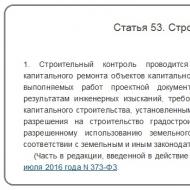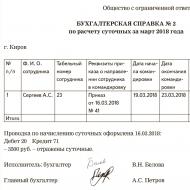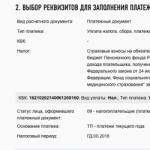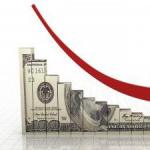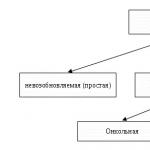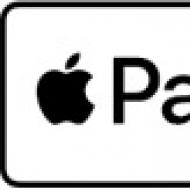
Types of taxation systems of the Russian Federation: osno, usn, envd, eskhn. Simplified taxation system All about usn in simple words
The simplified taxation system is established in the Tax Code in Chapter 26.2. This system is purely voluntary, it cannot be forced to apply. But, when switching to the simplified tax system, it will have to be applied at least until the end of the year. Switching to another mode is not allowed (except in certain cases).
Organizations using the simplified tax system may not pay:
- income tax;
- VAT (excluding import operations);
- property tax.
Entrepreneurs (IE) do not pay on the simplified tax system:
- Personal income tax;
- property tax;
- VAT (again, excluding the import of goods by import).
Previously, simplifiers still could not pay the UST (unified social tax). But since 2016, everyone has been obliged to pay insurance premiums, which introduced instead of the UST.
Organizations applying the simplified system need to keep accounting for all sections, i.e. in full, regardless of the fact that they keep tax records. But individual entrepreneurs may not keep accounting if they keep tax records, the basis is paragraph 2 of Article 6 of the Accounting Law 402-FZ. To maintain tax accounting all simplifiers apply the “Book of Income and Expenses” of the approved form.
So, what is the simplified tax system, if we talk in simple words? This is an opportunity for a small business to replace the payment of the three main taxes (on profit, VAT, on property) with one tax for simpliers, and how to calculate it is determined by the simplist himself (this will be discussed later).

Taxpayers
First, let's decide on those who can use the simplified tax system. During the initial creation of a legal entity - an organization or when registering an individual entrepreneur, anyone can declare their desire to use this system.
If an organization or individual entrepreneur already exists and decides to switch to the simplified tax system, then there are conditions that they must meet in order to be able to apply this regime.
The notification on the application of the simplified tax code from next year is submitted until the end of the current year.
The specific deadline for filing the notification is not specified, but from the text of Article 346.13 it follows an unambiguous conclusion that this is the entire fourth quarter (from 01.10 to 31.12). Because to switch to the simplified tax system, you need to indicate the income and the book (residual) value of fixed assets (fixed assets) exactly as of this date - October 1.
What does it take to transition to a simplified system? The following conditions must be met:
- income for 9 months did not exceed 45 million rubles;
- book value of fixed assets within 100 million;
- the average number of employees is not more than one hundred people;
- and everything else that is listed in paragraph 3 of article 346.12 had nothing to do with you.
In this case, you can safely send a notification to tax office and from January 1 to apply the simplified tax system.
Only then, applying the simplification, you need to remember to keep track of all these limits:
- revenue not more than sixty million;
- book value of fixed assets - one hundred million;
- employees - one hundred people, etc., so as not to "fly off", but according to the official, not to lose the opportunity to use the simplified tax system.
Object of taxation
The object of taxation is what will be taxed. The simplified system has two objects:
- income;
- income reduced by expenses.
With the object "income", the tax will be calculated at a rate of 6% only on the income received.
With a taxable object “income minus expenses”, the tax rate is 15%. In this case, the income received is reduced by the expenses incurred.
Which object to choose, everyone proceeds from the conditions of their own business. When providing services, when there are few costs, it is more profitable to choose a tax at a rate of 6%, while in trade, a 15% rate is more profitable.
In general, there is such a practical rule, if the expenses from the activities carried out make up 60% of the amount of income, in this case the calculated tax for both objects of taxation is the same.
Accordingly, if expenses are less than 60% of income, then it is better to choose an income object for use, if it is above 60%, then you need to choose income that we reduce to expenses.
The taxable object can be changed annually - you worked for a year with a 6% rate, did not like it, switched to 15% and vice versa.

In what order are income and expenses determined?
Applying the simplification, both income and expenses are taken into account cash method... What it is?
The cash method is the accounting of all transactions that are actually paid.
This means that income will be accepted for taxation if the money is credited to the cashier's office or to the current account.
There is one drawback - if advances are received, they will also be accepted for taxation. But to be taken into account for expenses, they must not only be paid, but also taken into account. That is, the operation must be completed: the goods are received and paid for, the services are provided and paid for, the work is performed and paid for, the salary is calculated and paid, etc.
If you paid one of the suppliers in advance for an operation that has not yet been completed, then it cannot be taken into account in expenses. So, our state does not issue laws to its own detriment. Pay the tax from the advance, and if you paid someone in advance, then wait until the obligations on it are fulfilled.
Accounting for income under the simplified tax system is carried out on the basis of the requirements of Chapter 25 of the Tax Code "Income Tax", in the same chapter there is article 251, not taken into account income for taxation of income tax. These same incomes will not be taken into account in the simplified tax system.
With expenses it is more complicated, what exactly will be taken into account is spelled out in article 346.16. The list of expenses is closed, that is, what is not in this list will not be adopted to reduce income. The list is quite impressive with 36 items, so we will not list everything. Again, the main criteria for accounting for expenses, as well as for income, are the criteria prescribed for expenses under the general taxation system.
Reporting and tax calculation
They report to the tax office under the simplified taxation system once a year (since this is the tax period for this tax). For organizations, March 31 is the last reporting day for the submission of the declaration. For all individual entrepreneurs, the last reporting day is April 30.
Within the same period, the tax charged in the declaration is paid. But besides the main tax payment, there are three terms for the advance payment for each quarter, no later than the 25th day of the next month. Everyone must calculate and pay the advance themselves. At the end of the year, the total tax amount is reduced by the amount already paid.
Tax is calculated as follows:
- Object "Income" (6%). Everything that has been transferred to the account, entered into the cashier, made settlements with suppliers and multiplied by 6% is summed up. Then this amount is reduced by the amount of the listed insurance premiums and paid at the expense of own funds disability benefits (sick leave), but not more than half. All who have employees, in any case, are obliged to pay 50% of the total tax to the budget. Individual entrepreneurs working independently (without hired workers) reduce the accrued tax by the amount of all paid contributions to the Pension Fund (pension fund) and the MHIF (compulsory medical insurance fund), which they will pay by the end of the current year.
- Object "Income reduced by expenses" (15%). Everything is simple here: they took income, deducted expenses, multiplied by the tax rate. But there is a small nuance. There is a concept of the minimum tax, it is equal to one percent of the amount of all income received during the year. When calculating tax in the standard way, a comparison is made with this amount. If the tax charged on general rule turns out to be less than the minimum tax, then the minimum tax must be paid to the budget. If, on the contrary, then you need to pay tax according to the general calculation. Simply put, whichever amount of the two is greater, that one needs to be paid to the treasury. Thus, it will not be possible to pay nothing to the state at all.
Transitional provisions
Article 346.25 sets out the rules that must be observed by those persons who, prior to application of the simplified tax system were on other tax regimes and vice versa, if they were on the simplified tax system, but decided not to apply this regime anymore (or "flew out" from it due to non-compliance with the limits). It is difficult to describe them, it is better to read in the Codex.
Additionally, read a short video about what the simplified tax system is in simple words, as well as the differences from traditional system and UTII:
Types of taxation systems in the Russian Federation: OSNO, STS, UTII, ESKhN.
OSNO- general taxation system (classical). Most often used in enterprises. In the classical taxation system OSNO, legal entity (organization or individual entrepreneur - individual entrepreneur) pays income tax, value added tax, unified social tax and other taxes, the need to pay of which is provided for by tax legislation, and also pays contributions to Pension Fund, Mandatory Fund health insurance, to the Social Insurance Fund.
STS- a simplified taxation system. It is a voluntary regime, in the application of which organizations are exempted from paying: VAT, income tax, property tax, insurance premiums, and individual entrepreneurs - VAT, personal income tax, property tax, insurance premiums. One tax is paid instead of the specified taxes. The rest of the taxes are paid in general order... The use of the simplified tax system can seriously reduce tax burden... To use it, it is enough to send a notification to the local tax office. But it is important to remember that there is a whole list of activities for which the use of the simplified tax system is prohibited. It is presented in Art. 346.12. p. 2 p.p. 1. of the second part of the Tax Code of the Russian Federation.
UTII – single tax on imputed income. The taxation system in the form of an imputed taxation system is a tax regime that is mandatory for organizations and individual entrepreneurs in the event that they carry out the types of activities provided for by law and meet the requirements. When applying the imputed taxation system in relation to activities related to the payment of the single tax, organizations are exempt from paying: VAT, income tax, property tax, insurance premiums, and individual entrepreneurs - VAT, personal income tax, property tax, insurance premiums. Instead of these taxes, a single tax is paid. The rest of the taxes are paid in accordance with the general procedure. From January 1, 2012, a phased cancellation of UTII is planned. That is, by that time, companies with no more than 15 people will be able to apply it. In addition, the types of activities that fall under this regime will be significantly reduced. Everyone is talking about the cancellation of UTII, but no one can say for sure when it will happen.Instead of a single tax on imputed income for certain types of activities, the new bill (On May 17, in the first reading, a bill was approved on the creation of a patent taxation system and the phased abolition of the single tax on imputed income), it is proposed to establish a voluntary special tax regime " Patent system taxation ". Recall that from 2012, individual entrepreneurs will be able to obtain a patent for the provision of services, and at the same time they will not have to pay income tax, property tax and VAT.
ESHN- unified agricultural tax. This mode, as a rule, is not in demand, so we will not waste time on it.
Tax rates
In addition to the taxation systems in the Russian Federation, it is necessary to determine its object. That is, to understand what the tax rate will be 6% (income) or 5-15% (income reduced by the amount of expenses). To do this, it is enough to calculate the approximate income, the amount of expenses and the possibility of confirming expenses. primary documents(checks, invoices, waybills etc.).
The object of taxation "income" is more profitable if:
Instructions
You can go to the "simplified" system in the application procedure. This means that if the taxpayer wishes from the next tax period use the simplified tax system, then he independently and voluntarily must apply to tax authorities with an application before December 31 of the current year. If the company has just been established, then an application for the use of this tax regime must be submitted within 30 days from the date of registration. "Simplified" is applied until the end of the tax period. The tax authorities must also be notified of the refusal from the simplified tax system in a declarative manner.
The law establishes certain restrictions on the use of the simplified taxation system by type of activity. Banks, pawnshops, Insurance companies, investment funds cannot use the simplified tax system. Companies that produce excisable goods or have branches cannot apply the “simplified” scheme either. The simplified tax system is a tax regime created to stimulate small and medium-sized businesses, therefore, additional restrictions were established on the volume of revenue, the residual value of fixed assets, and the number of employees. This tax regime can be used by organizations and individual entrepreneurs if the residual value of existing fixed assets is not more than 100 million rubles, and the number of hired workers does not exceed 100 people. In the application for the transition to the simplified tax system, it is mandatory to indicate the amount of revenue for nine months current period, it should not exceed 45 million rubles, and this threshold revenue is indexed annually by a coefficient-deflator. For example, in 2014 this ratio is 1.067. Therefore, for the transition to the simplified tax system from 2015, it is necessary that the income for nine months of 2014 does not exceed: 45 million rubles * 1.067 = 48.015 million rubles
The object of taxation is chosen by the taxpayer himself, based on the structure of income and expenses and the characteristics of his activities, for the entire calendar year. The object can be only received income or income reduced by the amount of expenses. If income is selected as an object, then to determine the tax, it is necessary to multiply all the proceeds received for the period by 6%. If the object selected is income reduced by the amount of expenses, then to determine the tax, it is necessary to deduct the amount of accounted expenses from the amount of income and multiply this difference by 15%.
The tax is transferred to the budget in advance payments no later than the 25th day of the month following the reporting period. Under the STS, the reporting period is a quarter, half a year and nine months. The total tax amount is determined taking into account advance payments and is paid to the budget by organizations by March 31, and by individual entrepreneurs by April 30 of the next calendar year.
Read about how you can compare tax systems in order to legally reduce payments to the budget when doing business. "And for those who still have questions or those who want to get advice from a professional, we can offer free consultation on taxation from 1C specialists:
Benefits of using the simplified tax system 2019
Simplified tax system, simplified tax system, simplified tax system - these are all names of the most popular taxation system among small and medium-sized businesses. The attractiveness of the simplified tax system is explained by both the small tax burden and the relative simplicity of accounting and reporting, especially for individual entrepreneurs.
In our service, you can prepare a notification of the transition to the simplified tax system for free (valid for 2019)
The simplified system combines two different taxation options that differ in the tax base, tax rate and the procedure for calculating taxes:
- STS Income,
Is it always possible to say that the simplified tax system is the most profitable and easy-to-account tax system? It is impossible to answer this question unequivocally, since it is possible that in your particular case the simplification will be not very profitable, and not very simple. But we must admit that the STS is a flexible and convenient tool that allows you to regulate the tax burden of a business.
It is necessary to compare tax systems according to several criteria, we propose to briefly go through them, noting the features of a simplified tax system.
1. Amounts of payments to the state when conducting activities on the simplified tax system
We are talking here not only about payments to the budget in the form of taxes, but also about payments for pension, medical and social insurance workers. Such transfers are called insurance premiums, and sometimes salary taxes (which is incorrect from the accounting point of view, but understandable for those who pay these contributions). make up on average 30% of the amounts paid to employees, and individual entrepreneurs are obliged to transfer these contributions for themselves personally.
Simplified tax rates are significantly lower than tax rates common system taxation. For the simplified tax system with the object "Income", the tax rate is only 6%, and since 2016 the regions have received the right to reduce tax rate on the simplified tax system Incomes up to 1%. For the simplified tax system with the object "Income minus expenses", the tax rate is 15%, but it can also be reduced by regional laws up to 5%.
In addition to the reduced tax rate, the STS Income has another advantage - the possibility of a single tax at the expense of the insurance premiums listed in the same quarter. Working in this mode legal entities and individual entrepreneurs-employers can reduce the flat tax by up to 50%. Individual entrepreneurs without employees on the simplified tax system can take into account the entire amount of contributions, as a result of which, with small incomes, there may not be a single tax to be paid at all.
On the STS Income minus expenses, the listed insurance premiums can be taken into account in expenses when calculating the tax base, but this calculation procedure is also valid for other tax systems, so it cannot be considered a specific advantage of the simplified system.
Thus, the simplified tax system is undoubtedly the most profitable tax system for a businessman if taxes are calculated based on the income received. Less profitable, but only in some cases, a simplified system can be compared to the UTII system for legal entities and individual entrepreneurs and in relation to the cost of a patent for individual entrepreneurs.
We draw the attention of all LLCs to the USN - organizations can pay taxes only by bank transfer. This is a requirement of Art. 45 of the Tax Code of the Russian Federation, according to which the obligation of the organization to pay the tax is considered fulfilled only after the payment order is submitted to the bank. The Ministry of Finance prohibits paying taxes to LLCs in cash. We recommend that you open a current account at favorable terms.
2. Labor intensity of accounting and reporting on the simplified tax system
According to this criterion, the STS also looks attractive. Tax accounting on a simplified system is kept in a special Book of Income and Expenses (KUDiR) for the simplified tax system (form,). Since 2013, legal entities on a simplified basis also maintain accounting, the individual entrepreneur does not have such an obligation.
So that you can try the accounting outsourcing option without any material risks and decide whether it suits you, we, together with 1C, are ready to provide our users with a month of free accounting services:
Reporting on the simplified tax system is represented by just one declaration, which must be submitted at the end of the year by March 31 for organizations and by April 30 for individual entrepreneurs.
For comparison, VAT payers, enterprises in the total tax system and UTII, as well as individual entrepreneurs at UTII submit declarations on a quarterly basis.
We must not forget that on the STS, in addition to the tax period, i.e. calendar year, there are also reporting periods - the first quarter, six months, nine months. Although the period is called the reporting period, according to its results it is not necessary to submit a declaration according to the simplified tax system, but it is necessary to calculate and pay advance payments according to the KUDiR data, which will then be taken into account when calculating the single tax at the end of the year (examples with the calculation of advance payments are given at the end of the article).
| More details: |
3. Disputes between payers of the simplified tax system with tax and judicial authorities
Not often taken into account, but a significant plus of the STS Income regime lies in the fact that the taxpayer in this case does not need to prove the validity and correct documentation of expenses. It is enough to record the income received in the KUDiR and, at the end of the year, submit a declaration according to the simplified tax system, without worrying that, according to the results office check arrears, penalties and fines may be charged due to non-recognition of certain expenses. When calculating the tax base in this regime, expenses are not taken into account at all.
For example, disputes with tax authorities over the recognition of expenses when calculating income tax and the validity of losses bring businessmen even to the Highest arbitration court(which are only cases of non-recognition by tax authorities of expenses for drinking water and toiletries in offices). Of course, taxpayers on the STS Income minus expenses must also confirm their expenses with correctly executed documents, but there are noticeably fewer disputes about their validity. Closed, i.e. strictly defined, the list of expenses that can be taken into account when calculating the tax base is given in article 346.16 of the Tax Code of the Russian Federation.
The simplified people are also lucky that they are not (except for VAT when importing goods into the Russian Federation), a tax that also provokes many disputes and is difficult to administer, i.e. accrual, payment and return from the budget.
STS is much less likely to lead to. On this system, there are no such criteria for the risk of checks, such as reporting losses when calculating income tax, high percent expenses in the income of an entrepreneur when calculating personal income tax and a significant share of VAT to be reimbursed from the budget. The consequences of an on-site tax audit for business are not related to the topic of this article, we only note that for enterprises the average amount of additional charges based on its results is more than one million rubles.
It turns out that the simplified system, especially the version of the STS Income, reduces the risks tax disputes and on-site inspections and it must be admitted to her additional advantage.
4. Possibility of work of taxpayers of the simplified taxation system with taxpayers in other regimes
Perhaps the only significant minus STS is to limit the circle of partners and buyers to those who do not need to take into account the input VAT. A VAT counterparty is likely to refuse to work with a simplified taxpayer, unless its VAT costs are offset by a lower price for your goods or services.
General information about USN 2019
If you find the simplified system beneficial and convenient for yourself, we suggest that you familiarize yourself with it in more detail, for which we turn to the original source, i.e. chapter 26.2 Tax Code RF. We will start our acquaintance with the simplified tax system with the one who can still apply this system taxation.
Can apply simplified tax system in 2019
Organizations (legal entities) and individual entrepreneurs ( individuals) unless they are subject to the range of restrictions below.
An additional restriction applies to an already operating organization, which can switch to a simplified regime, if, according to the results of 9 months of the year in which it submits a notification of the transition to the simplified tax system, its income from sales and non-operating income did not exceed 112.5 million rubles. These restrictions do not apply to individual entrepreneurs.
- banks, pawnshops, investment funds, insurers, private pension funds, professional participants securities market, microfinance organizations;
- organizations with branches;
- state and budgetary institutions;
- organizations conducting and organizing gambling;
- foreign organizations;
- organizations - participants in production sharing agreements;
- organizations, the share of participation in which other organizations is more than 25%, (with the exception of non-profit organizations, budgetary scientific and educational institutions and those in which authorized capital consists entirely of contributions from public organizations of people with disabilities);
- organizations, the residual value of fixed assets in which is more than 150 million rubles.
Cannot apply the simplified tax system in 2019
Organizations and individual entrepreneurs cannot use the simplified tax system:
- producing excisable goods (alcohol and tobacco products, cars, gasoline, diesel fuel, etc.);
- mining and selling minerals, except for the widespread ones, such as sand, clay, peat, crushed stone, building stone;
- those who switched to a single agricultural tax;
- having more than 100 employees;
- who did not report the transition to the simplified tax system within the time frame and in the manner prescribed by law.
The STS also does not apply to the activities of private notaries, lawyers who have established law offices, and other forms of lawyer formations.
To avoid a situation in which you cannot apply the simplified tax system, we recommend that you carefully consider the choice of OKVED codes for individual entrepreneurs or LLCs. If any of the selected codes correspond to the activities above, then report on it to STS tax will not allow. For those who doubt their choice, we can offer the service of free selection of OKVED codes.
Object of taxation on the simplified tax system
A distinctive feature of the simplified tax system is the possibility of a voluntary choice by the taxpayer of the object of taxation between “Income” and “Income reduced by the amount of expenses” (which is more often called “Income minus expenses”).
The taxpayer can make his choice between the objects of taxation "Income" or "Income minus expenses" annually, having previously informed the tax office before December 31 of his intention to change the object from the new year.
Note: The only restriction on the possibility of such a choice applies to taxpayers - participants in a simple partnership agreement (or on joint activity), as well as an agreement trust management property. The object of taxation on the simplified tax system for them can only be “Income minus expenses”.
Tax base on the simplified tax system
For the object of taxation "Income" the tax base is the monetary expression of income, and for the object "Income minus expenses" the tax base is the monetary expression of income reduced by the amount of expenses.
Articles 346.15 to 346.17 of the Tax Code of the Russian Federation specify the procedure for determining and recognizing income and expenses in this regime. Income on the simplified tax system is recognized as:
- income from sales, i.e. proceeds from the sale of goods, works and services own production and previously acquired, and proceeds from the sale of property rights;
- non-operating income specified in Art. 250 of the Tax Code of the Russian Federation, such as property received free of charge, income in the form of interest under loan agreements, credit, bank accounts, securities, positive exchange rate and amount difference, etc.
The costs recognized under the simplified system are given in Art. 346.16 of the Tax Code of the Russian Federation.
Tax rates for the simplified tax system
The tax rate for the STS Income option is generally 6%. For example, if you received income in the amount of 100 thousand rubles, then the tax amount will be only 6 thousand rubles. In 2016, the regions received the right to reduce the tax rate on the STS Income to 1%, but not everyone enjoys this right.
The usual rate for the STS option “Income minus expenses” is 15%, but the regional laws of the constituent entities of the Russian Federation can reduce the tax rate to 5% to attract investments or develop certain types of activities. You can find out what rate is valid in your region at the tax office at the place of registration.
For the first time registered individual entrepreneurs on the simplified tax system can receive, i.e. the right to work at a zero tax rate if the relevant law is passed in their region.
Which object to choose: STS Income or STS Income minus expenses?
There is a fairly conventional formula that allows you to show at what level of expenses the amount of tax on the STS Income will be equal to the amount of tax on the STS Income minus expenses:
Income * 6% = (Income - Expense) * 15%
In accordance with this formula, the STS tax amounts will be equal when expenses amount to 60% of income. Further, the more expenses are, the less tax payable will be, i.e. with equal incomes, the STS option will be more profitable. Income minus expenses. However, this formula does not take into account three important criteria that can significantly change the calculated tax amount.
1. Recognition and accounting of expenses for calculating the tax base on the STS Income minus expenses:
STS expenses Income minus expenses must be properly documented. Unconfirmed expenses will not be included in the calculation of the tax base. To confirm each expense, you must have a document confirming its payment (such as a receipt, account statement, payment order, cashier's check) and a document confirming the transfer of goods or the provision of services and the performance of work, i.e. invoice for the transfer of goods or an act for services and works;
Closed list of expenses. Not all expenses, even if they are properly executed and economically justified, can be taken into account. A strictly limited list of expenses recognized for the STS Income minus expenses is given in Art. 346.16 of the Tax Code of the Russian Federation.
A special procedure for recognizing certain types of expenses. So, in order for the STS Income minus expenses to take into account the costs of purchasing goods intended for further sale, it is necessary not only to document the payment for these goods to the supplier, but also to sell them to your buyer (Article 346.17 of the Tax Code of the Russian Federation).
An important point- selling means not the actual payment for the goods by your buyer, but only the transfer of the goods into his ownership. This issue was considered in the Resolution of the Supreme Arbitration Court of the Russian Federation No. 808/10 of 29.06. 2010, according to which "... it does not follow from tax legislation that the condition for including the cost of purchased and sold goods in expenses is their payment by the buyer." Thus, in order to set off the costs of purchasing a product intended for further sale, the simplified person must pay for this product, post it and sell it, i.e. transfer ownership to your buyer. The fact that the buyer pays for this product when calculating the tax base on the STS Income minus expenses will not matter.
Another one difficult situation is possible if you received an advance payment from your customer at the end of the quarter, but did not manage to transfer money to the supplier. Suppose a trading and intermediary company on the simplified tax system received an advance payment of 10 million rubles, of which 9 million rubles. must be paid for the goods to the supplier. If, for some reason, they did not have time to pay with the supplier in reporting quarter, then according to its results you have to pay advance payment based on the received income of 10 million rubles, i.e. 1.5 million rubles (at the usual rate of 15%). Such an amount can be significant for the STS payer who works with the buyer's money. In the future, after correct registration, these costs will be taken into account when calculating the single tax for the year, but the need to pay such amounts immediately may become an unpleasant surprise.
2. The ability to reduce the single tax on the simplified tax system Income due to paid insurance premiums... It has already been said above that in this regime it is possible to reduce the single tax itself, and in the STS regime Income minus expenses, insurance premiums can be taken into account when calculating the tax base.
✐Example ▼
3. Reduction of the regional tax rate for the simplified tax system Income minus expenses from 15% to 5%.
If your region has adopted a law establishing a differentiated tax rate for taxpayers applying the simplified tax system in 2019, then this will be a plus in favor of the simplified tax system option Income minus expenses, and then the level of expenses may even be less than 60%.
✐Example ▼
The procedure for switching to the simplified tax system
Newly registered business entities (IE, LLC) can switch to the simplified tax system by submitting no later than 30 days from the date state registration... Such a notification can also be submitted to the tax office immediately along with the documents for registration of an LLC or registration of an individual entrepreneur. Most inspectorates ask for two copies of the notification, but some inspectorates require three. One copy will be given back to you with a stamp from the tax office.
If, according to the results of the reporting (tax) period in 2019, the taxpayer's income on the simplified tax system exceeded 150 million rubles, then he loses the right to use the simplified system from the beginning of the quarter in which the excess was allowed.
In our service, you can prepare a notification of the transition to the simplified tax system for free (relevant for 2019):
Already working legal entities and individual entrepreneurs can switch to the simplified tax system only from the beginning of a new calendar year, for which a notification must be submitted no later than December 31 of the current year (notification forms are similar to those indicated above). As for UTII payers who have ceased to conduct a certain type of activity on imputation, they can apply for the simplified tax system within a year. The right to such a transition is given by paragraph 2 of paragraph 2 of Article 346.13 of the Tax Code of the Russian Federation.
Single tax for the simplified tax system 2019
Let's figure out how taxpayers should calculate and pay tax on the simplified tax system in 2019. The tax paid by the simplified people is called a single tax. A single tax replaces the payment of income tax, property tax, etc. for enterprises. Of course, this rule is not complete without exceptions:
- VAT must be paid to simplified taxpayers when importing goods into the Russian Federation;
- Property tax must be paid by enterprises on the simplified tax system, if this property, according to the law, will be assessed by cadastral value... In particular, since 2014, such a tax must be paid by enterprises that own retail and office space, but so far only in those regions where the relevant laws have been adopted.
For individual entrepreneurs, a single tax replaces personal income tax from entrepreneurial activity, VAT (except for VAT when imported into the territory of the Russian Federation) and property tax. Individual entrepreneurs can receive exemption from paying tax on property used in entrepreneurial activity if they apply to their tax office with an appropriate application.
Tax and reporting periods on the simplified tax system
As we have already figured out above, the calculation of the single tax differs on the STS. Income and STS. Income minus expenses by its rate and tax base, but for them they are the same.
The tax period for calculating the tax on the simplified taxation system is a calendar year, although we can only talk about this conditionally. The obligation to pay tax in installments or in advance payments arises at the end of each reporting period, which are a quarter, half a year and nine months of a calendar year.
The deadlines for the payment of advance payments for the single tax are as follows:
- at the end of the first quarter - April 25;
- at the end of the half-year - July 25;
- based on the results of nine months - October 25.
The single tax itself is calculated at the end of the year, taking into account all advance payments already made quarterly. The deadline for payment of tax on the simplified tax system at the end of 2019:
- until March 31, 2020 for organizations;
- until April 30, 2020 for individual entrepreneurs.
For violation of the terms of payment of advance payments for each day of delay, a penalty is charged in the amount of 1/300 of the refinancing rate of the Central Bank of the Russian Federation. If the single tax itself is not listed for the year, then in addition to the fine, a fine of 20% of the unpaid tax amount will be imposed.
Calculation of advance payments and a single tax on the simplified tax system
Calculated according to the accruing single tax, i.e. summarizing from the beginning of the year. When calculating an advance payment based on the results of the first quarter, the calculated tax base multiply by the tax rate, and pay that amount by April 25th.
Considering the advance payment for the first half of the year, the tax base received for 6 months (January-June) must be multiplied by the tax rate, and from this amount the advance payment already paid for the first quarter must be deducted. The remainder must be transferred to the budget by July 25.
The calculation of the advance for nine months is similar: the tax base calculated for 9 months from the beginning of the year (January-September) is multiplied by the tax rate and the amount received is reduced by the advances already paid for the previous three and six months. The remaining amount must be paid by October 25th.
At the end of the year, we will calculate a single tax - we multiply the tax base for the whole year by the tax rate, subtract all three advance payments from the resulting amount and make the difference by March 31 (for organizations) or by April 30 (for individual entrepreneurs).
Tax calculation for STS Income 6%
The peculiarity of the calculation of advance payments and the single tax on the STS Income is the ability to reduce the calculated payments by the amount of insurance premiums transferred in the reporting quarter. Enterprises and individual entrepreneurs with employees can reduce tax payments by up to 50%, but only within the limits of the contributions. Individual entrepreneurs without employees can reduce the tax on the entire amount of contributions, without a limit of 50%.
✐Example ▼
IE Aleksandrov on the simplified tax system Income, who does not have employees, received an income in the 1st quarter of 150,000 rubles. and paid in March insurance premiums for himself in the amount of 9,000 rubles. Advance payment in 1 sq. will be equal to: (150,000 * 6%) = 9,000 rubles, but it can be reduced by the amount of contributions paid. That is, in this case, the advance payment is reduced to zero, so there is no need to pay it.
In the second quarter, an income of 220,000 rubles was received, for a total of half a year, i.e. from January to June, the total amount of income was 370,000 rubles. The entrepreneur also paid insurance premiums in the second quarter in the amount of 9,000 rubles. When calculating the advance payment for the six months, it must be reduced by the contributions paid in the first and second quarters. Let's calculate the advance payment for the six months: (370,000 * 6%) - 9,000 - 9,000 = 4,200 rubles. The payment was made on time.
The entrepreneur's income for the third quarter was 179,000 rubles, and he paid 10,000 rubles in insurance premiums in the third quarter. When calculating the advance payment for nine months, we first calculate the entire income received from the beginning of the year: (150,000 + 220,000 + 179,000 = 549,000 rubles) and multiply it by 6%.
The amount received, equal to 32,940 rubles, will be reduced by all paid insurance premiums (9,000 + 9,000 + 10,000 = 28,000 rubles) and by the advance payments transferred at the end of the second quarter (4,200rubles). In total, the amount of the advance payment for nine months will be: (32,940 - 28,000 - 4,200 = 740 rubles).
Until the end of the year, IE Aleksandrov earned another 243,000 rubles, and his total annual income was 792,000 rubles. In December, he paid the remaining amount of insurance premiums of 13,158 rubles *.
* Note: according to the rules for calculating insurance premiums in force in 2019, individual entrepreneurs' contributions for themselves are 36,238 rubles. plus 1% of income exceeding 300 thousand rubles. (792,000 - 300,000 = 492,000 * 1% = 4920 rubles). At the same time, 1% of income can be paid at the end of the year, until July 1, 2020. In our example, the individual entrepreneur paid the entire amount of contributions to this year to be able to reduce the single tax at the end of 2019.
Let's calculate the annual single tax of the simplified tax system: 792,000 * 6% = 47,520 rubles, but during the year advance payments (4,200 + 740 = 4,940 rubles) and insurance premiums (9,000 + 9,000 + 10,000 + 13 158 = 41,158 rubles).
The sum of the single tax at the end of the year will be: (47,520 - 4,940 - 41,158 = 1,422 rubles), that is, the single tax was almost completely reduced due to the insurance premiums paid for themselves.
Tax calculation for STS Income minus expenses 15%
The procedure for calculating advance payments and tax under the STS Income minus expenses is similar to the previous example with the difference that income can be reduced by expenses incurred and the tax rate will be different (from 5% to 15% in different regions). In addition, insurance premiums do not reduce the calculated tax, but are taken into account in total amount costs, so it makes no sense to focus on them.
✐Example ▼
Let's enter quarterly income and expenses of the company LLC "Vesna", operating on the STS mode Income minus expenses, in the table:
Advance payment for the 1st quarter: (1,000,000 - 800,000) * 15% = 200,000 * 15% = 30,000 rubles. The payment was paid on time.
Let's calculate the advance payment for the six months: income on an accrual basis (1,000,000 + 1,200,000) minus expenses on a cumulative total (800,000 + 900,000) = 500,000 * 15% = 75,000 rubles minus 30,000 rubles. (paid advance payment for the first quarter) = 45,000 rubles, which were paid before July 25.
The advance payment for 9 months will be: income on an accrual basis (1,000,000 + 1,200,000 + 1,100,000) minus expenses on a cumulative total (800,000 + 900,000 + 840,000) = 760,000 * 15% = 114,000 rubles. Let us subtract from this amount the advance payments paid for the first and second quarters (30,000 + 45,000) and we will receive an advance payment for 9 months equal to 39,000 rubles.
To calculate the single tax for the year, we summarize all income and expenses:
income: (1,000,000 + 1,200,000 + 1,100,000 + 1,400,000) = 4,700,000 rubles
expenses: (800,000 + 900,000 + 840,000 + 1,000,000) = 3,540,000 rubles.
We calculate the tax base: 4,700,000 - 3,540,000 = 1,160,000 rubles and multiply by the tax rate 15% = 174 thousand rubles. Let us subtract from this figure the advance payments paid (30,000 + 45,000 + 39,000 = 114,000), the remaining amount of 60 thousand rubles will be the sum of the single tax payable at the end of the year.
For taxpayers on the simplified tax system Income minus expenses there is also an obligation to calculate the minimum tax at the rate of 1% of the amount of income received. It is calculated only at the end of the year and is paid only if the tax charged in the usual manner is less than the minimum or is absent at all (upon receipt of a loss).
In our example, the minimum tax could have been 47 thousand rubles, but Vesna LLC paid a total of 174 thousand rubles a single tax, which exceeds this amount. If the single tax for the year, calculated in the above way, turned out to be less than 47 thousand rubles, then there would be an obligation to pay the minimum tax.


